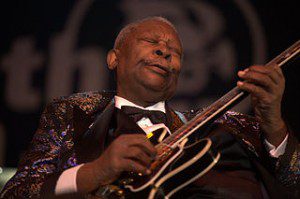
WHO:
B.B. KING | KING OF BLUES
WHEN:
FRIDAY, JANUARY 3, 2014 | 8 P.M.
WHERE:
BOB CARR PERFORMING ARTS CENTRE | ORLANDO, FLORIDA
ON SALE:
FRIDAY, SEPTEMBER 20, 2013 | 10 A.M.
Over the last six decades, there has been only one King of the Blues – Riley B. King, affectionately known as B.B. King. Since King started recording in the late 1940’s, he has released over 60 albums many of them considered blues classics, like 1965’s definitive live blues album “Live At The Regal,” and 1976’s collaboration with Bobby “Blue” Bland, “Together For The First Time.”
Throughout King’s career, he had two number one R & B hits, 1951’s “Three O’Clock Blues” and 1952’s “You Don’t Know Me” along with four number two R & B hits, 1953’s “Please Love Me,” 1954’s “You Upset Me Baby,” 1960’s “Sweet Sixteen, Part I” and 1966’s “Don’t Answer The Door, Part I.” King’s most popular crossover hit, 1970’s “The Thrill Is Gone,” went to #15 on the pop charts.
King’s first big break came in 1948 when he performed on Sonny Boy Williamson’s radio program on KWEM out of West Memphis. This led to steady performance engagements at the 16th Avenue Grill in West Memphis and later to a ten minute spot on WDIA called, “King’s Spot.” It became so popular that it was increased in length and became the “Sepia Swing Club.” Soon, King needed a catchy radio name. What started out as Beale Street Blues Boy was shortened to Blues Boy King, and eventually B.B. King. Incidentally, King’s middle initial “B” is just that, it is not an abbreviation.
Soon after his number one hit, “Three O’Clock Blues,” King began touring nationally and he has never looked back; performing an average of 125 concerts a year. In 1956, King and his band played an astonishing 342 one night shows. From small town cafes, theaters, country dance halls and roadside joints to jazz clubs, rock palaces, symphony concert halls, college concerts, resort hotels and prestigious concert halls nationally and internationally, King has become the most renowned blues musician of the last 60 years.
King’s technique is nonetheless complex, featuring delicate filigrees of single string runs, punctuated by loud chords, subtle vibratos and “bent” notes. The technique of rock guitar playing is a large degree derived from King’s playing. He developed one of the world’s most readily identified guitar styles. He borrowed from Lonnie Johnson, Blind Lemon Jefferson, T-Bone Walker and others, integrating his precise vocal-like string bends and his left hand vibrato, both of which are indispensable components of rock guitarist’s vocabulary. He has been a model for thousands of players including Eric Clapton, George Harrison and Jeff Beck.
“I’m me,” King told Time Magazine in 1969, “blues is what I do best. If Frank Sinatra can be the best in his field, Nat King Cole in his, Bach and Beethoven in theirs, why can’t I be great and known for it, in blues?”
During King’s career, he has earned 15 Grammy® Awards. He was inducted into the Blues Foundation Hall of Fame in 1984 and into the Rock and Roll Hall of Fame in 1987, where Sting of the Police made the induction speech. King was named Act of the Year by Performance Award Polls in 1985, 1987 and 1988. He is a founding member of the John F. Kennedy Performing Arts Center. King received the Grammy “Lifetime Achievement Award” in December of 1987 at the first televised awards in May 1990. He won the Lifetime Achievement Award from the Blues Foundation in 1997.


